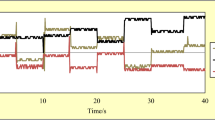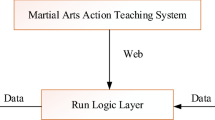Abstract
Virtual reality technology has been widely used in several fields, including sports and sports. As a traditional sport, Wushu requires high precision of skills and movements. Therefore, the use of virtual reality technology to intelligently assist the simulation of martial arts movements has great potential. The purpose of this study is to develop an intelligent assistant system for martial arts movement detection based on virtual reality technology, so as to improve the skill and movement accuracy of martial arts learners. The optical imaging technique is used to capture and record martial arts movements. Then the captured data is input into the virtual reality simulation system, the virtual reality technology is used to create character models and environmental scenes, and the martial arts action is simulated in the virtual scene. Finally, intelligent algorithms are used to analyze and evaluate virtual simulated actions, providing feedback and guidance to learners. The experimental results show that the use of light imaging based on virtual reality can effectively improve the accuracy of martial arts learners' skills and movements. Learners can find and correct their own movement problems by comparing and feedback with simulated movements in the virtual scene.





Similar content being viewed by others
Data availability
The data will be available upon request.
References
AbelCORCUERA, A.L., Jr.: The webinar experiences of higher education instructors in the time of emergency remote education. Int. J. Sch. Educ. 4(2), 134–145 (2021)
Arpaci, I.: The role of self-efficacy in predicting use of distance education tools and learning management systems. Turk. Online J. Dist. Educ. 18(1), 52–62 (2017)
Bottani, E., Vignali, G.: Augmented reality technology in the manufacturing industry: a review of the last decade. IISE Trans. 51(3), 284–310 (2019)
Chen, P.J., Penn, I.W., Wei, S.H., Chuang, L.R., Sung, W.H.: Augmented reality-assisted training with selected Tai-Chi movements improves balance control and increases lower limb muscle strength in older adults: a prospective randomized trial. J. Exerc. Sci. Fit. 18(3), 142–147 (2020)
Chen, F., Cui, X., Han, B., Liu, J., Zhang, X., Liao, H.: Augmented reality navigation for minimally invasive knee surgery using enhanced arthroscopy. Comput. Methods Prog. Biomed. 201, 105952 (2021)
Cheng, J., Wang, Y., Tjondronegoro, D., Song, W.: Construction of interactive teaching system for course of mechanical drawing based on mobile augmented reality technology. Int. J. Emerg. Technol. Learn. (online) 13(2), 126–139 (2018)
Deng, L., Pu, Y.: Analysis of college martial arts teaching posture based on 3D image reconstruction and wavelet transform. Displays 69, 102044 (2021)
Edwards-Stewart, A., Hoyt, T., Reger, G.: Classifying different types of augmented reality technology. Annu. Rev. Cyberther. Telemed. 14, 199–202 (2016)
Kara, M., Erdogdu, F., Kokoç, M., Cagiltay, K.: Challenges faced by adult learners in online distance education: a literature review. Open Praxis 11(1), 5–22 (2019)
Li, S., Huo, S., Ke, W.: Intelligent decision-making system for martial arts competition using deep learning. Mob. Inf. Syst. 2021, 1–8 (2021)
Menolotto, M., Komaris, D.S., Tedesco, S., O’Flynn, B., Walsh, M.: Motion capture technology in industrial applications: a systematic review. Sensors 20(19), 5687 (2020)
Przhedetskaya, N., Borzenko, K.: Marketing model of promotion of remote education by modern university. Int. J. Educ. Manag. 33(3), 446–453 (2019)
Samir, S., Emary, E., El-Sayed, K., Onsi, H.: Optimization of a pre-trained AlexNet model for detecting and localizing image forgeries. Information 11(5), 275 (2020)
Schuller, A.L.: At the crossroads of control: the intersection of artificial intelligence in autonomous weapon systems with international humanitarian law. Harv. Nat’l Sec. J. 8, 379 (2017)
Shurygin, V., Saenko, N., Zekiy, A., Klochko, E., Kulapov, M.: Learning management systems in academic and corporate distance education. Int. J. Emerg. Technol. Learn. (Ijet) 16(11), 121–139 (2021)
Süğümlü, Ü.: A case study on teaching Turkish through distance education. Int. J. Psychol. Educ. Stud. 8(1), 174–190 (2021)
Zhang, H., Wang, L., Chu, S., Chen, S., Meng, H., Liu, G.: Application of optical motion capture technology in power safety entitative simulation training system. Opt. Photon. J. 6(8), 155–163 (2016)
Funding
The authors have not disclosed any funding.
Author information
Authors and Affiliations
Contributions
WM has done the first version, SZ and WM has done the simulations. All authors have contributed to the paper’s analysis, discussion, writing, and revision.
Corresponding author
Ethics declarations
Conflict of interest
The authors declare that they have no competing interests.
Additional information
Publisher's Note
Springer Nature remains neutral with regard to jurisdictional claims in published maps and institutional affiliations.
Rights and permissions
Springer Nature or its licensor (e.g. a society or other partner) holds exclusive rights to this article under a publishing agreement with the author(s) or other rightsholder(s); author self-archiving of the accepted manuscript version of this article is solely governed by the terms of such publishing agreement and applicable law.
About this article
Cite this article
Maotang, W., Zhifeng, S. & Mingyong, W. Simulation of optical imaging detection based on virtual reality assisted technology in intelligent assistance system for martial arts actions. Opt Quant Electron 56, 265 (2024). https://doi.org/10.1007/s11082-023-05872-9
Received:
Accepted:
Published:
DOI: https://doi.org/10.1007/s11082-023-05872-9




